 Abengoa
Abengoa
Annual Report 2012
- Corporate Social Responsibility
- Environment
- Calculating Abengoa’s main environmental indicators
In calculating Abengoa’s environmental indicators4, worksites, associated activities and all projects directly promoted by the company were taken into account.
For all other projects, figures relating to company business were reported, but excluding raw materials, consumption or waste attributable to the promoters of said projects and likewise excluding maintenance or operating activities carried out at customer facilities or purchases made between Abengoa companies.
Raw material inputs
Optimizing the use of natural resources and appropriate resource management are part of Abengoa’s commitment to being sustainable. For this reason, resource impact and management are carefully examined in order to be able to quantify the use made of materials consumed, adaptation of products for reuse and efficiency in production and transportation methods. Each year the company carries out an exhaustive inventory of materials purchased with the aim of extending the range of its commitment to sustainability in this area.
Shown below is a list of the main raw material inputs used by activity.

The rise in the use of certain raw materials in construction activities was brought on by a high construction project volume, which increased purchasing of resources and consumption of binding materials used for this activity, including concrete, cement, plaster, etc.

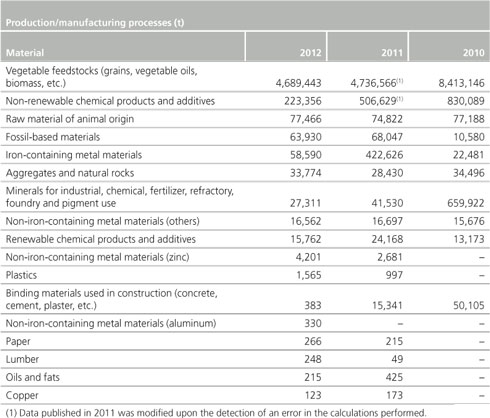
Abengoa, conscious of the growing problem entailed by global waste generation, provides waste collection, treatment and valorization services that help prevent the use of primary natural resources and limit the environmental impacts derived from wastes.

The percentage of all materials used that are neither virgin materials nor materials for primary use totaled 31 %.
Energy
Rising world demand for energy necessitates new solutions in this field, giving preference to solutions that make use of clean, inexhaustible sources. Abengoa applies innovative technology solutions that transform energy from renewable sources into electricity and biofuels; builds transmission lines that provide the essential structure for electric systems; while at the same time promoting responsible use based on autonomy, energy diversification and the implementation of efficiency initiatives that are extended to the company’s processes and activities.
The table below contains a breakdown by fuel type of the primary energy consumption associated with the entire range of production processes and construction activities.

Data on the amount of electrical power consumped from the grid corresponds to permanent work facilities, including both production plants and offices, and to projects undertaken directly by Abengoa.

In keeping with the company’s commitment to clean technologies, 23 % of the electricity consumed at Abengoa comes from renewable energy sources.
If we transform this electrical consumption to the primary sources utilized for electricity generation, according to International Energy Agency (IEA) data for the different countries where Abengoa operates, the result is as follows:
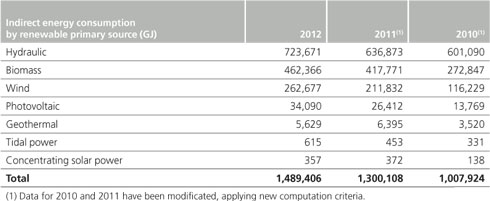

The breakdown of energy produced and sold in 2012 is shown below:

Worth noting is that 27 % of electrical power production is of solar origin.
Another essential underpinning in fulfilling Abengoa’s sustainability policies and objectives is the implementation of measures that help to reduce energy use with respect to the company’s activity growth. For this reason, in 2012 a variety of initiatives were undertaken with a focus on energy efficiency enhancement. Noteworthy among them are the following:
- Replacement of the gas turbine for a higher efficiency turbine at Ecocarburantes Españoles, Murcia (Spain). The measure involved an investment of 2,927,617 €.
- Installation of a variable-flow climate control system at Campus Palmas Altas, Seville (Spain). The measure involved an investment of 77,220 €.
- Optimized electrical use through the implementation of a variety of improvement initiatives and plans at the Simosa IT data processing centers in Valgrande, Madrid (Spain) and Montesierra (Seville). The measure involved an investment of 28,000 €.
Further measures were implemented, including office light fixture replacement, central air conditioning and heating system enhancements, and power adaptation applied to production plant systems.
Water
Each year, Abengoa quantifies its impact derived from obtaining water in order to explore new strategies and thereby contribute to more sustainable use in the future.
According to Abengoa’s information system, none of the sources used to collect water is on the Ramsar list of wetlands or may be considered especially sensitive. Nor is there any record of cases in which annual consumption totals more than 5 % of the volume of the sources affected.
The company’s policy on sustainability prioritizes reduction at source by minimizing the amount used, reutilizing the resource for activities in which potability is not a key factor, or using alternatives to collection from water supply networks intended for human consumption.


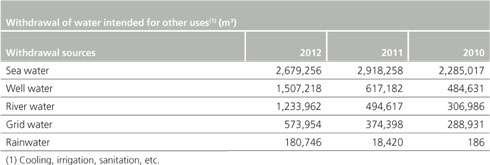
As in the case of energy consumption, the company focuses its efforts on regulating water consumption, particularly in activities involving more intensive use of this resource.
A case in point is the initiative undertaken at Campus Palmas Altas consisting of the installation of pumps for regulating water distribution according to demand and alternative systems for meeting off-peak demand, which takes on special importance in a geographical location such as Seville, an area enduring particular water stress.
The amount of reutilized water accounts for 4.70 % of the total volume of water collected by Abengoa.
The variation in reutilized water with respect to data reported in previous years is attributed to the application of new computation criteria, having established that for productive processes with closed cycles only circuit water volume should be taken into account, regardless of the number of times the cycle is performed.
Effluents and discharges
Abengoa, keenly aware of the potential impacts of its activities, for companies whose nature of operations negatively alters the composition of the water utilized, suitable water treatment is undertaken, with final quality being rendered within the limits established under legal requirements before being discharged into a public water source or sewer network.
Likewise, all dumping operations are authorized and controlled by competent agencies in order to ensure conformity and minimize their impact on the environment.
Abengoa performs rigorous monitoring every year of the release of effluents and discharges arising from its activities, as can be seen in the table below.

Among the initiatives aimed at improving control over the water discharged into the environment is the implementation of a ph control and correction mechanism for the reverse osmosis unit that accounts for most of the effluent flow at the Ecocarburantes Españoles (Murcia) company. This measure involved an investment of 31,285 €.
In relation to effluent discharge-related incidents, Abengoa information channels reported three minor incidents that did not entail any action from the competent authorities.
In 2012, a total of 86 spills were reported through the Abengoa information channels, with the cost of repair totaling 53,675 €. There were no significant spills, and in most cases the environment was not affected.
Wastes
The different types of wastes Abengoa generates as a product of normal company operations are monitored through the environmental management systems in place at each company. The most significant of these wastes are listed below according to final destination.
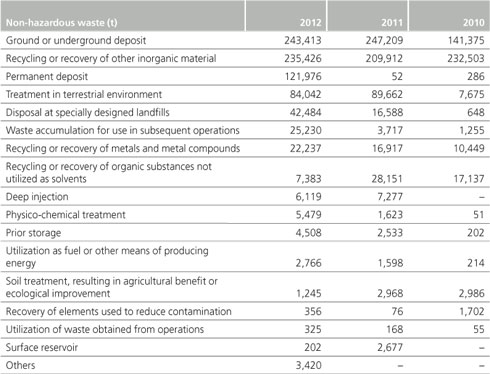

The year-on-year rise in waste generation is primarily due to the increase in works in progress, higher production at a number of plants, and the one-off dismantling of a plant in Biscay (Spain).
Furthermore, the variability in final treatment can be put down to the different phases in which the range of projects are found and the fact that waste destination may change depending on the final handling agent.
In the waste management and recycling segment, Abengoa is responsible for transporting hazardous wastes. The table below shows the main figures associated with these transportation operations.

NOx, SOx, CO, VOC, particle and ozone layer-depleting substance emissions
Shown below are the emissions reported in 2012 for ozone layer-depleting substances.

NOx, SOx, CO, VOC and particle emissions reported in 2012 are listed below.

As a result of the improvement in computing emissions of gases different from greenhouse gas gases, some companies have made adjustments to the basis for calculation in order to obtain a truer result. This is the main reason for the differences with respect to last year’s emissions.
Managing biodiversity
Preserving biodiversity requires a management approach based on a combination of elements involving prevention, management and restoration of any damage that may be caused to the natural habitats in which the company operates. Abengoa therefore minimizes its impacts by establishing a positive correlation with habitats and animal and plant species that are more sensitive to human activity.
With this in mind, Abengoa has conducted environmental impact studies and monitoring tasks for operations carried out on land adjacent to or lying within protected areas, including the identification of affected species and valuation and assessment of resulting impacts.
Conserving these habitats is an objective that encompasses restoration and reforestation plans, strategies geared towards protecting plant and animal species, and training in forest fire prevention, etc.
Although Abengoa has companies in Brazil, France, South Africa and Spain that are located within protected areas, none of them has a particular impact on the ecosystem according to the company’s information channels.
Abengoa Brasil (Brazil) is particularly relevant in this regard, as the company is involved in five electrical power transmission line construction projects that affect a combined protected area of 46,727 ha. This company is carrying out a series of initiatives aimed at preserving biodiversity:
- Plant replacement and upkeep in areas affected by activity, with investment totaling
- 132,054 €.
- Inventory, monitoring and analysis of the situation of affected species; protection and transfer of species to safer places in order to reduce environmental impact. The cost involved totaled 2,976,973 €.
Further activities to have been carried out in 2012 include perimeter enclosure and reforestation of land adjacent to the construction zone at the CSP complexes located in Cáceres and Ciudad Real (Spain). Such measures are valued at 313,167 €.
Products, services and transportation
For some sectors, the environmental impacts of products and services during their life time and at the end of their useful life can be equal to or greater in significance than those resulting from the production phase. Such impacts constitute an environmental challenge that is becoming more and more important each day. As Abengoa’s products and services are sustainble by nature, there have been no reports of any initiatives to mitigate the environmental impacts of products and services, nor have there been any reports of significant quantities of products, packages and containers to have been recovered.
The Abengoa reporting system did not identify any significant impacts derived from transporting products and other goods and materials used for the organization’s operations or in transporting members of the workforce. Nevertheless, an initiative has been undertaken to substitute the vehicle fleet for other more efficient vehicles at Abentel, Seville (Spain). The cost associated with this measure totaled 94,500 €.
Environmental expenditures and investments
Calculating environmental protection and mitigation expenditures enables Abengoa to determine the efficiency of its environmental initiatives. The following table provides a breakdown of environmental expenditures and investments.
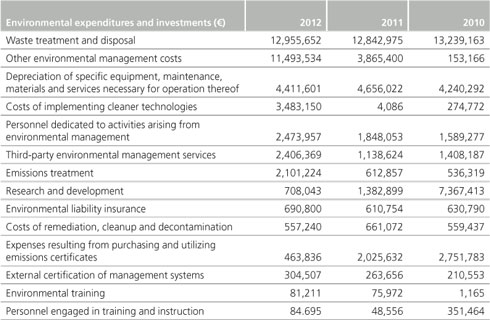
In 2012, Abengoa clearly embraced the development of initiatives and projects aimed at environmental protection. Proof of this is found in the rise in investment allocated for this purpose by the company in most of the areas in which it invests. Noteworthy are allocations to environmental management costs and investment in emissions treatment, which have tripled, in addition to the investment made in all aspects of environmental training and education.
In 2012, one infraction involving an odor contamination problem was reported in the Netherlands, as well as awaste-related violation in Murcia, Spain. The cost of the former infringement totaled 60,000 € and the latter amounted to 170,000 €. There have been no reports at Abengoa of any other incidents.
Note 4: All indicators were calculated using specific measurement and computation protocols in order to standardize applicable criteria.
© 2012 Abengoa. All rights reserved
